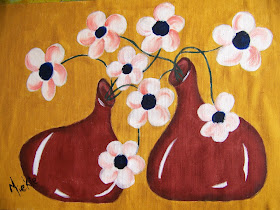I want to enlarge the A4 designs to double their size. I therefore use one of my A3 paper pads to guide me in getting the sizes right by tracing the outline of the book on the Tabling Linen I will be using to paint on. I measure three of these.
I use a pair of scissors dedicated to cutting only fabric to cut the blocks.
My brother has a projector mounted to the ceiling and I put my USB memory stick directly into this.
The selected image(s) are projected onto the screen. When using a computer interface, you will find you have even more options open to manipulate the images. These images can be downloaded from APrettyTalent.com by clicking here.
I zoom to the desired size ...
... and then attach the fabric where the image is displayed against the board.
For the second image I did not trace the petals of the flowers as I will be using a paint technique with a Filbert brush to paint these.
The last design also makes use of paint techniques to paint the petals and once again I did not trace these. The type of craft you use the design for will determine which aspects to trace and which to leave out.
I paint the pots with Dala Oxide Fabric Paint. I use two brushes throughout, except for signing my name at the end. The brushes are both Angle Brushes; a medium and a small.
I paint the rim of the opening of the flower pot Black over the Oxide with a dry brush. I then paint another layer of Oxide over the Black to soften it.
The inside of the pot is painted White over the Oxide. I then paint a smudge of dry black in the center of the opening to indicate depth.
The whole pot is painted Oxide. I paint the edges Black with a dry brush, sweeping in from the line. I then soften the black with more Oxide. This will assist in fooling the eye to believe in the roundness of the pot.
The reflections on the pot is painted White.
I repeat the steps for the other pot as well.
The next step is to paint the background Ochre.
You will note that I took great care to preserve the unpainted areas for the flowers and the stems.
The centers of the flowers are painted Blue.
I then paint the centers Black while the blue is still wet. I actually want Black centers, but I do not want the Black to be too stark and therefore add this tinge of Blue to them.
I am not sure that you can see the results on the photo, but try it for yourself. You will be surprised by the much livelier Black that is achieved this way.
As I do not have any Green left in my supplies, I decide to mix my own. I use a palette knife to mix the paint. A dollop of Blue is added first.
I then add a dollop of Ochre to the Blue.
The Green that results from this will stand me just fine.
I turn the angle brush on its side to make tidy lines when I paint the stems of the flowers.
The painting is coming on nicely. I like the white flowers, but need to add depth as well as to make them less stark.
I find that I have already mixed the ideal color in a previous project. I used White with only a tinge of Scarlet to mix a very warm white.
The flowers are painted this warm white. Can you see how it softens the appearance of the still white petals?
I use the smaller angle brush to smear dry streaks of Scarlet in the petals to achieve a sense of dimension.
The Scarlet is softened when I paint another coating of the warm white over it.
Finally I use a round brush with long tapered bristles and Black paint to sign my name. Stand the brush on its point to achieve fine lines.
That concludes the painting of the first design.
The first steps for the second painting is a repetition of the first. The only difference is in the painting of the flower petals. I bring the second painting to this point.
I use a large Filbert brush, that is a flat brush that is rounded at the top, to paint the flower petals with. I once again use the color I mixed from White and Scarlet.
Dip only the tip of the brush in the paint. Gently touch it to the painting, standing it right on its tips. With only a slight sweep towards the center of the flower, lift the brush off the painting.
The result is a fine petal with just a hint of a narrower tail towards the center of the flower.
Complete all the flowers in this way.
I put only a smudge of Scarlet in each of the petals with a small Filbert brush.
Gently touch the smudges with the mixed color again to blend it slightly.
You can now lay these designs aside to concentrate on the last one, which we will tackle in the next blog.
These images can be downloaded from APrettyTalent.com by clicking here.
For more crafty ideas and great products, visit APrettyTalent.com.
Remember to keep nurturing your TALENT for making PRETTY things.
You can subscribe to this blog and receive regular updates by email by simply registering your email address at the top of the current blog.










































No comments:
Post a Comment